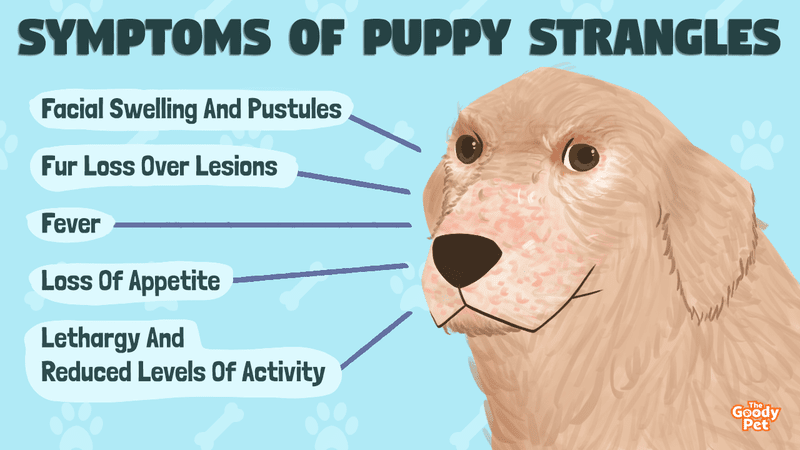Dogs can suffer from a number of skin conditions. The most common are allergic reactions and infestation by parasites like fleas and mites. There are a few lesser known skin issues that you may come across with puppy strangles disease being one of the most interesting.
Puppy strangles disease is known medically as juvenile cellulitis and is a rare autoimmune skin condition that mainly affects puppies. It appears suddenly as swelling of the face and progresses rapidly eventually causing heavy scabbing and crusting over the affected skin.
Puppy strangles disease is about so much more than just aesthetics. It can be debilitating and can negatively impact the dog’s quality of life, albeit temporarily. If you suspect your pup has strangles disease, you have come to the right place.
We will take a look at all you need to know about the condition including what causes it, what you can do for your dog, and even how to prevent it.
What Is Puppy Strangles Disease?
Puppy strangles disease is a very rare skin condition that causes dermatitis and scarring mainly around the face. It is also known as juvenile cellulitis.
In order to understand puppy strangles disease and what it means for your doggy, you have to understand its distinguishing features. Here are the most important things you should know about the disease.
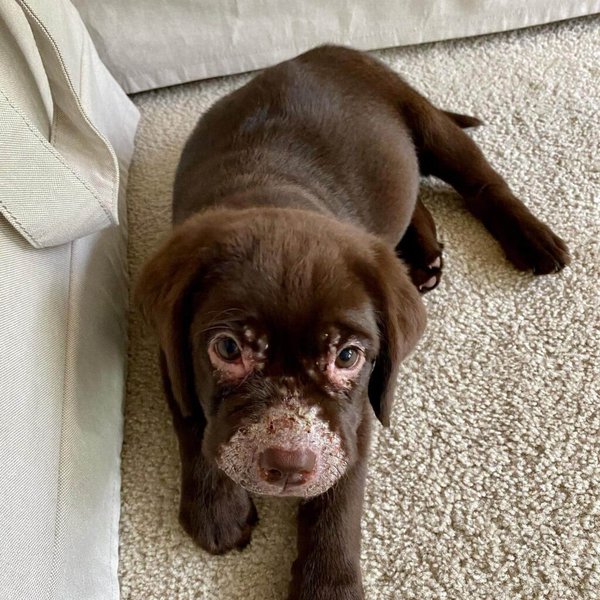
How Is It Acquired?
Despite appearances and similarities to contagious skin conditions, juvenile cellulitis is not contagious in puppies. The disease is believed to be as a result of inherited immune anomalies that cause an autoimmune response.
Age Group Affected
As the terms, “juvenile” and “puppy” in this condition’s name suggest, strangles disease occurs mainly in young dogs. It can occur as early as the first month of life or even earlier in some cases. It is very rare for dogs older than 6 months to get the disease.
Dog Breed Affected
Puppy strangles disease can occur in any dog breed. However, there are a few that are more commonly affected than others. These include Golden Retrievers, Dachshunds, and Beagles just to name a few.
Onset And Progress
Another important point to note about puppy strangles is that it appears suddenly and progresses very quickly. You will first notice generalized swelling over the dog’s face which progresses to pus-filled pimples then crusts and scabs within a few days.
Resolution
Puppy strangles do not go away on their own so you will need to get a vet involved for prompt and aggressive treatment. With this, it will take about 10 to 14 days for the puppy strangles to completely heal.
What Are The Symptoms Of Puppy Strangles?
For the most part, puppy strangles is an inflammatory condition of the skin.
However, it may have other general symptoms affecting different systems in the dog’s body. Here are both the skin and non-dermatologic symptoms of puppy strangles that you have to keep an eye out for.
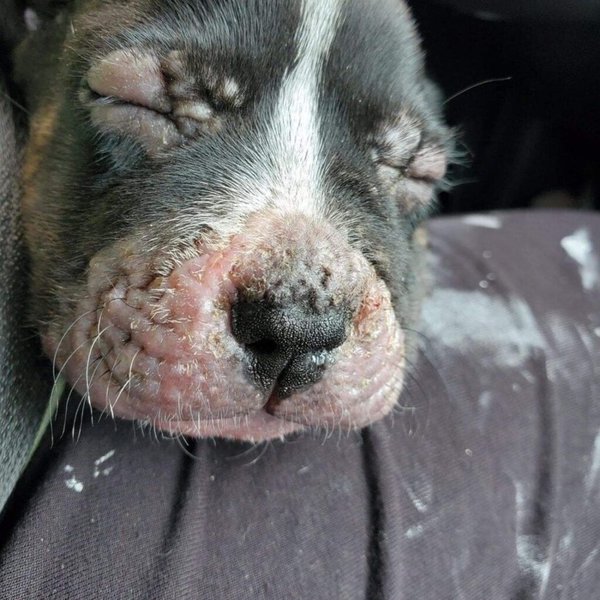
Facial Swelling And Pustules
This is the most important sign of puppy strangles. The swelling starts off as general and is usually localized to facial structures like the snout and chin. It may also appear around the eyes and forehead.
A few days after this swelling, you may notice pus-filled pustules that rupture on their own and leave crusty discharge on the dog’s skin and coat.
Fur Loss Over Lesions
The facial swelling is also often accompanied by a gradual loss of fur over the affected areas. Fortunately, this is not a permanent process. With successful treatment, the fur will eventually grow back fully.
Fever
The puppy may also be feverish when they get puppy strangles. You may notice the dog panting a lot as a way to regulate their temperature and get more comfortable.
Lethargy And Reduced Levels Of Activity
Puppy strangles usually take a huge physical toll on the puppy which you will pick up on as lethargy and general disinterest in activities that they previously enjoyed.
Loss Of Appetite
The dog may also have reduced appetite levels. This is mainly due to the discomfort especially if the lesions are around the snout and mouth. Eating in these cases just makes the dog more uncomfortable.
What Causes Puppy Strangles?
The actual cause of puppy strangles is not actually known. However, there are many theories on the source and disease process with most experts proposing that it is an inherited autoimmune condition.
This means that the puppy’s immune system is at fault and it attacks the dog itself.
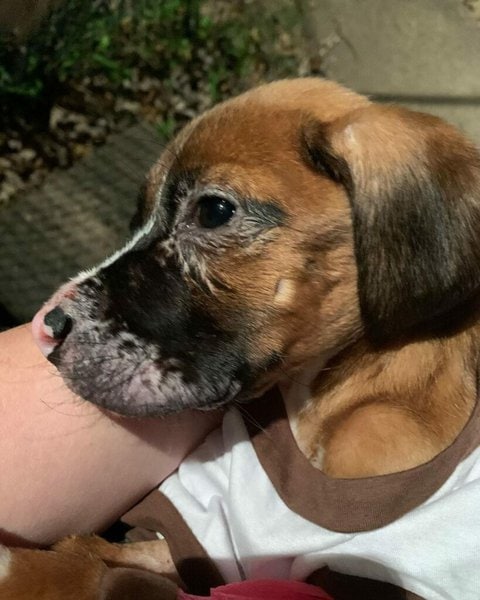
While the actual cause may not be known, there are a few identified causes of complications that you may have to actively avoid. Here are 2 important factors that result in complications like cellulitis.
Bacterial Infections
Technically speaking, puppy strangles is not an infection but is rather an inflammation of the skin due to autoimmune processes taking place in the dog.
However, with the progression of puppy strangles involving ruptured pustules and ulceration of the skin, there is a very serious risk of the dog developing secondary infections.
Bacteria on the dog’s coat and in the environment take advantage of the broken skin to colonize and infect the puppy. This causes skin infections and may even result in life-threatening complications like sepsis.
Delayed Treatment
It is very important that you understand that puppy strangles disease will not go away on its own. The dog’s immune system will continue to attack unless it is stopped. By delaying treatment, the processes responsible for puppy strangles are allowed to continue uninterrupted.
This results in more severe symptoms and discomfort for the dog. It could also result in long-term complications like heavier scarring and even permanent fur loss over the affected areas.
It is, therefore, best to take your dog to the vet for evaluation as early as the swollen face stage even if you are not sure it is puppy strangles.
How Do You Treat Strangles In Puppies?
Fortunately, puppy strangles is treatable. The prognosis is also quite good especially when the treatment is started early and you adhere to the plan laid out by your dog’s vet.
Here are some of the common treatments used when managing a dog with puppy strangles disease.
Immunosuppressants
These are usually corticosteroids like prednisone. They work by suppressing the overactive and faulty immune system in the dog that is responsible for the autoimmune attack on the skin.
However, it is important that the young puppies are not kept on these drugs for too long as their immune systems are immature and already vulnerable to attack by pathogens.
Antibiotics
In cases where the puppy has suffered a secondary infection of the strangles lesions, antibiotics may be given. These kill the bacteria that are taking advantage of the broken skin and prevent serious complications like sepsis.
If your dog is put on antibiotics, you have to make sure they finish their dose for effectiveness and to prevent resistance.
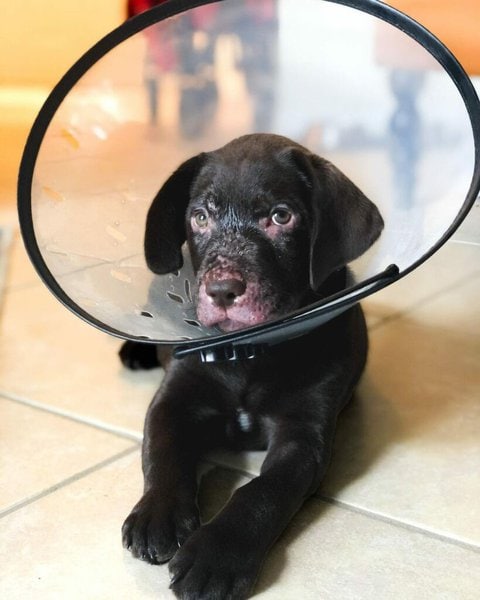
Pain Killers
Puppy strangles disease is very painful and uncomfortable for the little pooch. Pain killers are a great way to put them out of their misery.
Pills and injections work the best as they take care not only of the pain from the skin lesions but also discomfort including joint pain that is associated with strangles.
Skin Soothing Ointments
Finally, you could use soothing ointments to help reduce the pain, inflammation, and even itchiness if your dog is experiencing this.
In some cases, these ointments combine the medications we have highlighted including the corticosteroids and antibiotics for multiple effects all from one application.
How Do You Prevent Strangles?
Unfortunately, there is no strangles vaccine or any one magic tip you can apply to completely prevent strangles especially if your dog is already genetically predisposed to the condition.
The best you can do is take good enough care of the dog that if and when the strangles disease hits, it is not as devastating as it would have been.
Here are 4 very simple ways you can prevent puppy strangles from getting to complicated levels.
Invest In Your Dog’s Dental Hygiene
Given the proximity of the strangles lesions to the mouth, there is always the risk of oral bacteria causing infections when the dog licks themselves.
Dental water additives as well as actually cleaning your dog’s mouth on a regular basis will help minimize the chances of this contamination.
Use Medicated Shampoo On Affected Puppies
Using medicated shampoos will help you avoid complications like secondary infections. We recommend the Veterinary Formula Clinical Care Antiparasitic & Antiseborrheic Medicated Dog Shampoo in this case for a vet-approved formula that actually works. The best part is that this shampoo has colloidal oatmeal extracts which help soothe irritated skin in strangles.
Give Your Dog Immune Supplements
Boosting your puppy’s immune system may seem counterintuitive when dealing with an autoimmune disease. However, it is actually a very effective way to prevent complications in strangles.
Immune supplements support healthy functionality of the immune system which also includes stabilizing it in case of anomalies that result in autoimmunity. We recommend Zesty Paws Allergy Immune Supplement For Dogs whose soft chew formulation makes them very easy to administer.
Related Questions
Can A Dog Get Puppy Strangles Twice? Puppies do not often get strangles disease twice. With time and treatment, puppy strangles will resolve completely in a couple of weeks and you may never have to deal with it again. However, it is not completely impossible for strangles to recur in which case the vet may recommend a longer-term treatment.
Can Humans Get Strangles? Humans cannot get strangles from their puppies. This is because strangles is an autoimmune condition with hereditary patterns of transmission. It can therefore only be passed from affected dogs to their offspring especially if they are bred with other dogs that have the same defective genetics responsible for puppy strangles.
Can Cellulitis Kill A Dog? Cellulitis refers to an infection of deep tissues within the skin and can kill the dog if it is associated with sepsis and widespread tissue necrosis. Juvenile cellulitis on the other hand or puppy strangles disease, is simply an inflammation of the skin and is rarely fatal especially if there are no infections involved.

